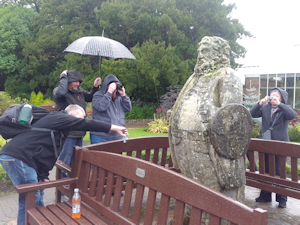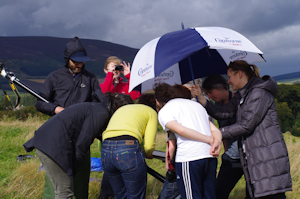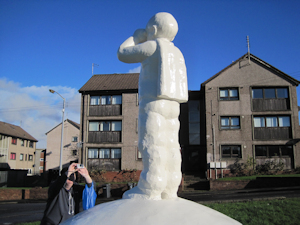
On viewing finished 3D digital visualisations they are rarely peopled. They exist in what looks to be a pristine, uncluttered world. As discussed previously this, however, means that they occupy a 'weird' space (Jeffrey 2015). But we can re-introduce the reality of the messiness of our interactions with the landscape, terrain, monument and each other when we consider their making. In ACCORD everyone captured data with their smartphone, tablet or camera. This is choreographed by the monument being recorded; movements that are dictated by the terrain and physicality of the standing stone, building, or object. This affords an experience dictated to some degree by the landscape and monument; on fieldwork it becomes apparent how some people are already in tune with the monument and terrain, while others stumble in. The three-dimensional model, when viewed in Agisoft Photoscan with the 'cameras' turned on, captures this dance. These representations are testament to the 'we' in data capture. Yet we often discard these interim representations of the process and only the finished product is communicated and archived. I agree with Matthew Ritchie, the Forestry Commission Scotland archaeologist, who has spoken of how he finds beauty in the point clouds themselves before they are meshed and textured, their traditional form of presentation or publication (pers. comm.). Some archaeologists have commented on the invisibility of the stages involved in processing and have suggested that we should give them their due attention and should even include interim screenshots/files in archives (Huggett pers. comm.). The importance of recording paradata is therefore paramount - our very own equivalent of 'labanotation' (the language used by dancers to record their movements). Furthermore, paradata should also include personal reflections on the making process from the authors/artists, in addition to contextual information on the subject's conditions.

A particularly attractive feature of photogrammetry and RTI as technologies since their release into the mainstream, now almost ten years ago, is that they are relatively inexpensive and processing can be done using free open-source software (e.g. 123D-Catch, Arc 3D, Memento). These techniques do not have to be carried out in solitude and, depending on the location, it is often much more efficient and effective to work together in a group. This has led to these technologies being welcomed into community heritage practice and there have been a series of very successful community archaeology and heritage projects (for example as part of Archaeology Scotland's 'Adopt-a-Monument' scheme, the Wemyss Cave 4D project run by the SCAPE trust, and the 'Re-reading the British Monument Project' run by Gareth Beale and Nicole Beale at the Centre for Digital Heritage, University of York). ACCORD embraced the 'we' by developing a co-design and co-production methodology where heritage was not pre-defined but was a deliberately open concept (Jeffrey et al. 2015). In the ACCORD portfolio you can find more traditional forms of heritage (wheelhouses, standing stones and the like) alongside rock-climbs, graffiti, and a contemporary sculpture by living artist and sculptor Kenny Hunter. Focus groups were held with each community to define and agree on what heritage had the most significance for them, and although some had a clear idea even before we arrived on the scene (for example the cairn, as discussed above), for others the discussion brought to the fore perhaps previously unexpressed attachments to place (for ACCORD examples of this discussed in full see Jeffrey et al. in prep). Sometimes, though, this was elucidated through actually doing and taking part in the process of recording. In particular, the process of photogrammetry is particularly good at establishing a relationship with a monument, landscape or place through a process of mutual learning: in Ingold's words 'we know as we go, not before we go' (Ingold 2000, 230, original emphasis).

For example, to return to when we worked together with the CGDT, one participant and recent recruit passionately encouraged the group to record the memorial dedicated to local soldiers who fell at Gallipoli in World War 1. This person had recently moved back to his childhood home of Colintraive from Australia and was interested in the connection to this Australian/New Zealand Army Corps (ANZAC), who were fundamental in the battle of Gallipolli, 1915. Surprisingly, the others in the group did not know the whereabouts of this monument; some did not even know of its existence. After persuasion at the co-design focus group, he directed us all to the site, which was situated just off the main road towards Colintraive down an unmarked overgrown path. Many members of the group were still unconvinced at this point, as this was certainly not a route well trodden. However, his enthusiasm rubbed off and as we recorded the cairn monument recollections and stories of ancestors/friends who had lost their loved ones in the war flooded back. We awkwardly scrambled around the overgrowth in order to take enough photographs and while doing so we removed some of the nearby branches obscuring the monument (Figure 6). In this way, in these gestures, the group re-engaged with this monument. Since then the community have cleaned the immediate surrounding area, investing in its care. On the anniversary of Gallipoli in 2014 the community held a memorial service here, demonstrating how this monument has been reclaimed and is again part of the local narrative.

Photogrammetry also affords a different and very immediate way of experiencing a monument, landscape or place. Furthermore, doing this together enhances the experience through a process of mutual learning, reinforcing individual relationships with that monument, object or place. This is not always predictable. Different expectations and anticipations coalesce in the act of capturing the data together. As already mentioned, John Schofield (2014) has written on the dynamics of expert and non-expert relationships in archaeological practice and advocates an emancipatory archaeology. At the moment of data capture in ACCORD this barrier was broken down and relationships were re-negotiated. In fact, we (the heritage professionals) followed and did not lead. Recognising photogrammetry in particular as a tool with which to explore this uncharted terrain should be considered and is perhaps a means by which we can practice truly participatory and inclusive archaeology.


King of the Castle (3D PDF. Right-click to download)
Internet Archaeology is an open access journal based in the Department of Archaeology, University of York. Except where otherwise noted, content from this work may be used under the terms of the Creative Commons Attribution 3.0 (CC BY) Unported licence, which permits unrestricted use, distribution, and reproduction in any medium, provided that attribution to the author(s), the title of the work, the Internet Archaeology journal and the relevant URL/DOI are given.
Terms and Conditions | Legal Statements | Privacy Policy | Cookies Policy | Citing Internet Archaeology
Internet Archaeology content is preserved for the long term with the Archaeology Data Service. Help sustain and support open access publication by donating to our Open Access Archaeology Fund.